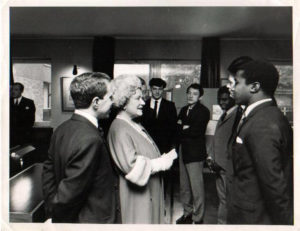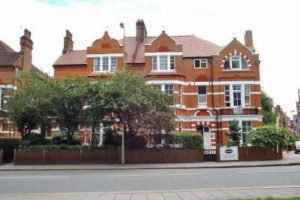
Netherhall House first opened its doors in 1952, promoted by some of the early members of Opus Dei in Great Britain with friends and colleagues who were not necessarily Catholics or Christian. From the very beginning, it sought to be a home from home for all the students who chose it as their residence during their university years in London. It was already the intention, during those early years, that Netherhall House should be an international hall of residence, providing a unique environment in which all students, whether from home or overseas, could sample the benefits of friendship and international co-operation amongst people of all nations, cultures and religions. The directors of the residence worked hard to make this happen, and, as the popularity of Netherhall House grew, they started to lay plans for an expansion which finally came in 1965 with construction of the new buildings in Nutley Terrace. These allowed for almost one hundred residents on the site and brand-new facilities for the Lakefield Catering School in Maresfield Gardens. In addition, seminar rooms, an auditorium and an Oratory were constructed. The development was partly funded by a grant from the Foreign and Commonwealth Office, administered by the British Council who were keen to help provide good accommodation. It was formally opened by Queen Elizabeth the Queen Mother in November 1966.
Meanwhile, the success of Netherhall House was leading to expansion elsewhere and so, in 1964, Netherhall Educational Association was formed to take over the work of the original Trust and to put this growth on a more secure footing. It was set up as a registered charity, devoted to helping people of all ages, but especially the young, to seek personal development within the Christian ideal. By then Grandpont House in Oxford had already been acquired, which began to admit, as residents, students in Oxford University. The house was getting on for 200 years old (in fact it was built in the same year as The Times newspaper was founded (1785)), a beautiful building sitting on a bridge on a branch of the River Isis, but in a bad state of repair. When the first residents moved in, most of the windows were broken and the house had not been properly cared for over a number of years. They set to work to repair the fabric of the house and little by little restored it to a functioning homely building.

Soon after NEA was set up, Kelston was acquired. This house faced onto Wandsworth Common in South London. Some students from Netherhall House began to spend the weekends at Kelston, to work on the house and to organise activities for schoolboys. It was not long before there were permanent residents at Kelston and a thriving club and study centre whose success down the years has benefitted more than 1500 young people, very many of whom have been regular members right through their secondary school years. Some of these have gone on to run Kelston themselves and also other centres of the Association. At the same time, NEA also purchased Wickenden Manor in Sussex, a country house built early in the twentieth century, although in a style that makes the first time visitor think it is considerably older. The Manor has extensive grounds that include another smaller house, called the Lodge, and a cottage called the Pheasantry. This became a venue for retreats, conferences and all kinds of study courses. At the same time, the Pheasantry was used to accommodate residential weekends in the countryside for young people, including the boys of Kelston Club.
From the beginning, it was the intention of Netherhall Educational Association to offer spiritual activities, entrusted to the Opus Dei Prelature, in each of its centres. This continues to be the case, and many people come to the centres specifically for this purpose. This forms one part of the outreach of centres such as Netherhall House, benefiting many more than those actually in residence at any given time. Netherhall House has a considerable outreach for its cultural activities too, filling its auditorium for concerts and plays, as well as attracting people to guest speakers and other events and activities. Spiritual activities are supported in each centre by the presence of a chaplain who is a priest of the Opus Dei Prelature.
In 1974, we started looking for a second house in London where we could start another club along the lines of Kelston. The success of Kelston was clear and boys seemed willing to travel to Kelston from many miles away, but a club is of its nature of more use to families who live within reasonable travelling distance, so it seemed a good idea to find a suitable property somewhere north of the river Thames. This is how Westpark in Ealing came to be purchased. In fact, it was not for sale at all, but the house, next to Ealing Common, was spotted by someone as he drove by and he decided to knock and ask if the owners would be willing to sell. After considering the matter, they decided they would. So again, a number of students moved in and started to run activities for schoolboys at weekends.
However, in the years that followed, plans were modified because space was needed for more student activities, and it was decided to discontinue schoolboy activities at Westpark for some years. In the meantime, the residents of Westpark set up a club in a house lent to them in Harrow, and Arnwood Club operated until 1995 when it lost its premises and it was decided that the time was ripe to start the Westpark Club once again. In 1998 a new clubhouse was completed in the garden of Westpark and a full programme of activities for boys between the ages of 10 and 18 now takes place there every weekend.
Another part of NEA’s history concerns the centres in Orme Court in Bayswater. 6 Orme Court was bought by the original Trust in 1962. In 1980-82 we were able to acquire Numbers 4, 5, 7 and 8. In the late 1980s, having purchased number 1, we carried out building works to link Number 1 at the back to numbers 4-8. These properties have been used as residential accommodation, called Elmore, since 1980. More building works have been carried out to help us make better use of the properties.
Also in 1980, NEA expanded into Scotland. After renting property initially, in 1982 we bought a flat in Beaumont Gate, Glasgow, close to the University and started to run activities for students, schoolboys, and adults. It was soon clear that this property was too small to do any of these things adequately, so we started to look around Glasgow for a new house. We found the ideal house in Nithsdale Road, Pollockshields, which, after repairs, became Dunreath Study Centre. At Dunreath we run seminars for university students, a club for schoolboys, a social project called Citywise for children from more deprived backgrounds to help them improve their school work, and a range of activities for adults in and around Glasgow (not to mention, as part of our outreach, in Edinburgh).

One of the biggest developments in NEA’s history came with the Netherhall 2000 project. Planned a decade ago, built between 1993 and 1995, and completed in several respects for the Millennium, this enabled us to complete Netherhall House in good time for its fiftieth anniversary in 2002. Victorian buildings were replaced with modern houses in the same style. We were able to increase available space by digging downwards to create a lower ground floor and also by building a central area between the new houses and the 1960s block. This once again brought Netherhall House’s capacity (reduced temporarily when the old buildings had to close) to over 100 residents, but this time all in single rooms, some with their own en suite bathroom. Netherhall House remains as popular as ever and is now fully equipped to provide a first-class service well into the new millennium.